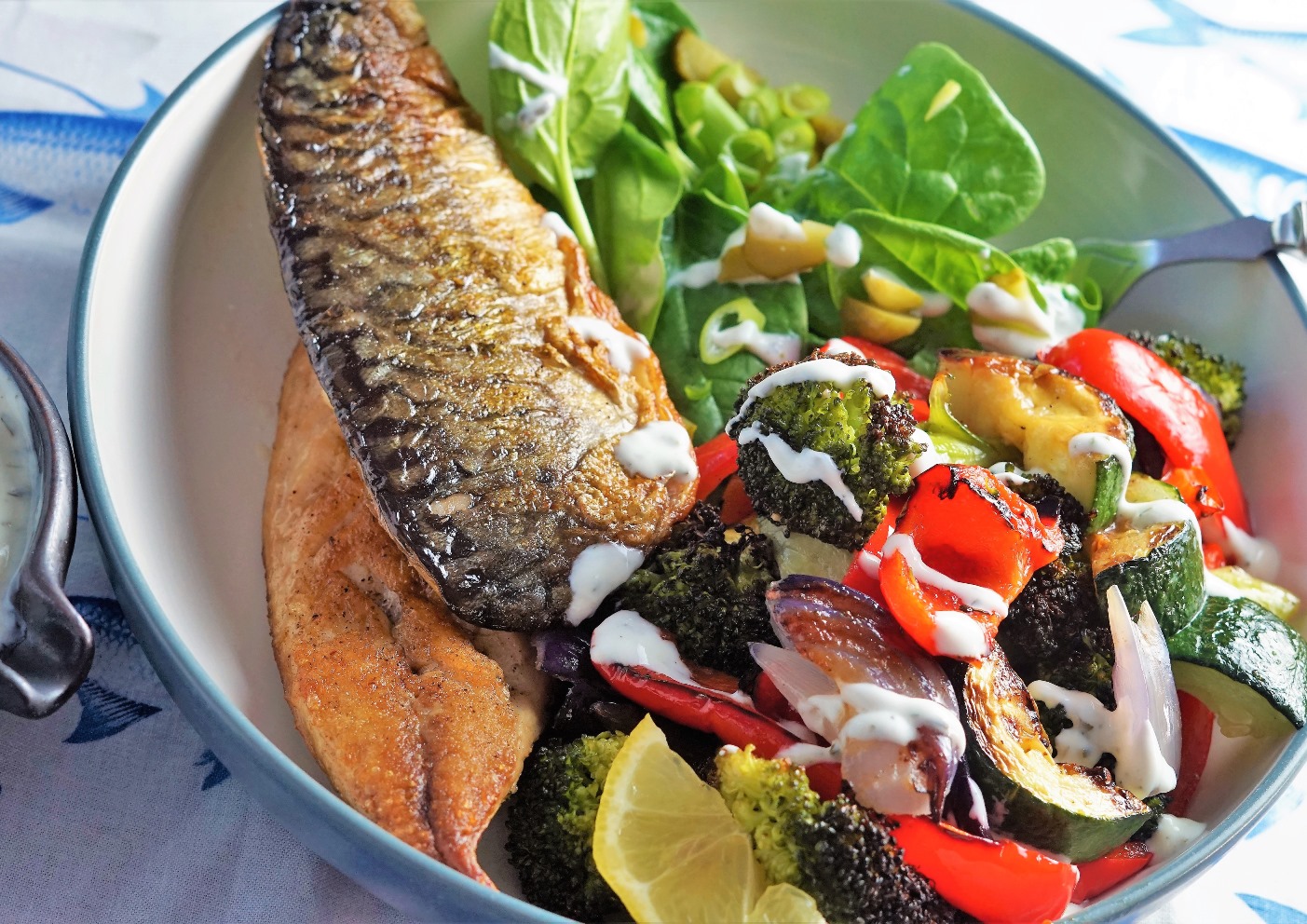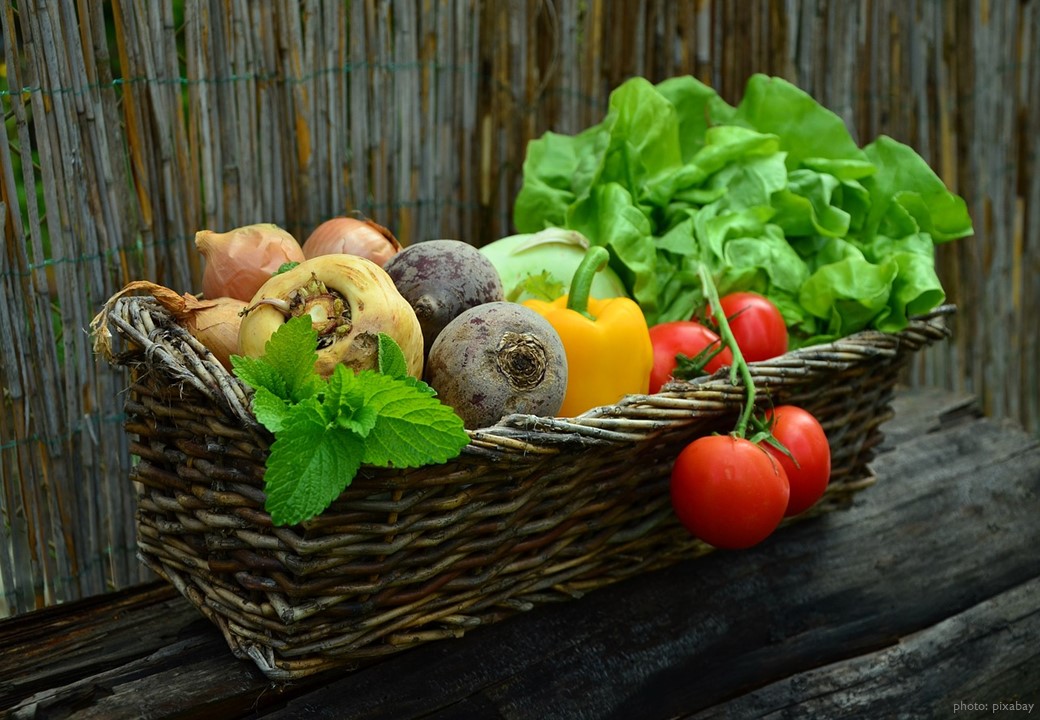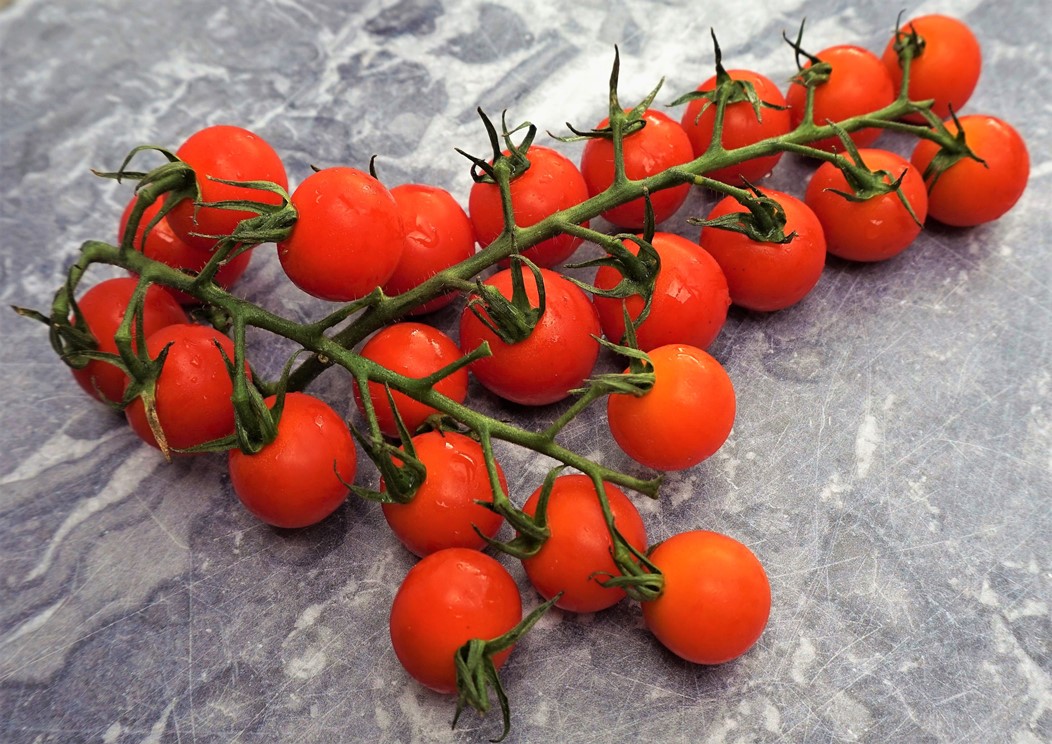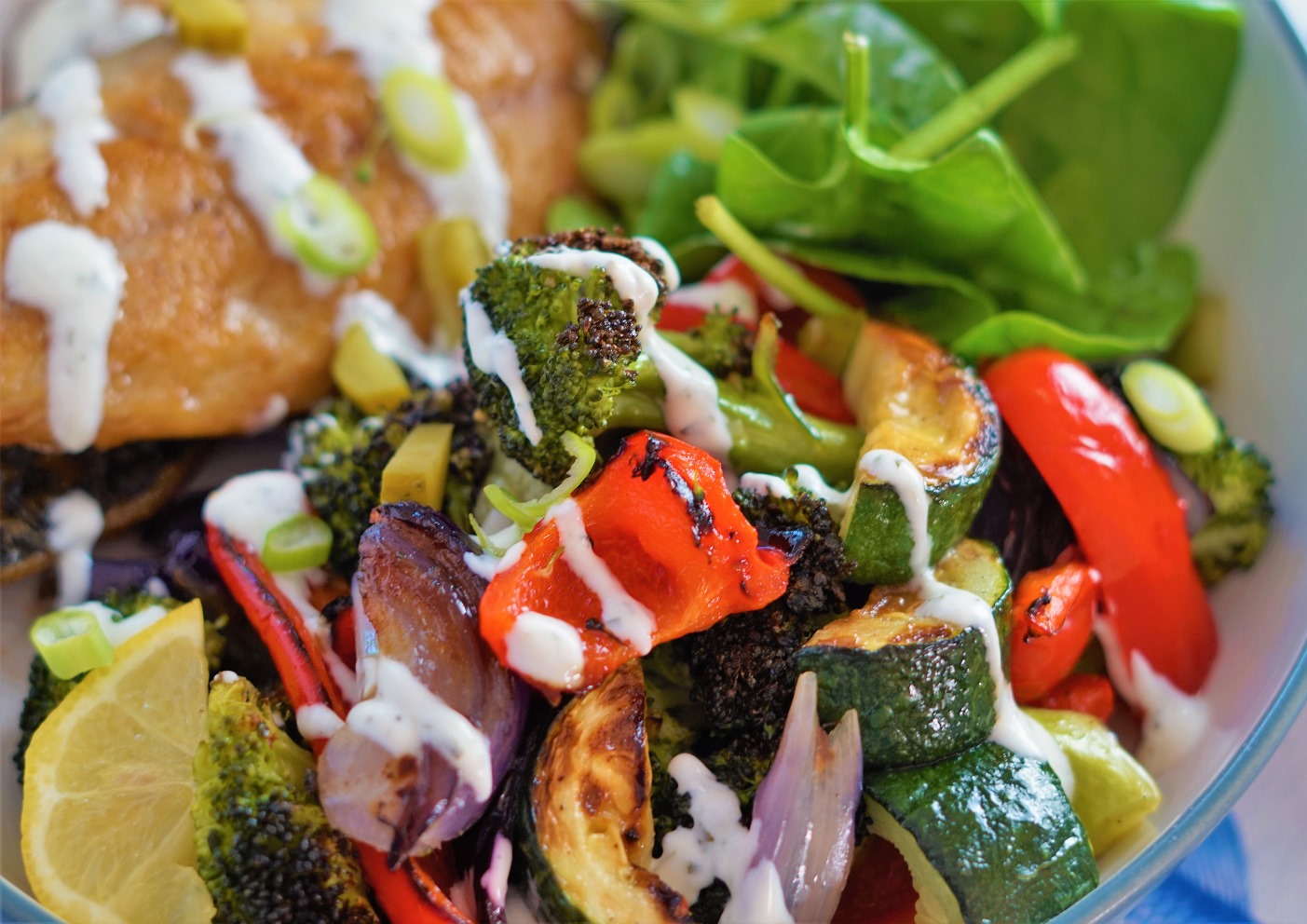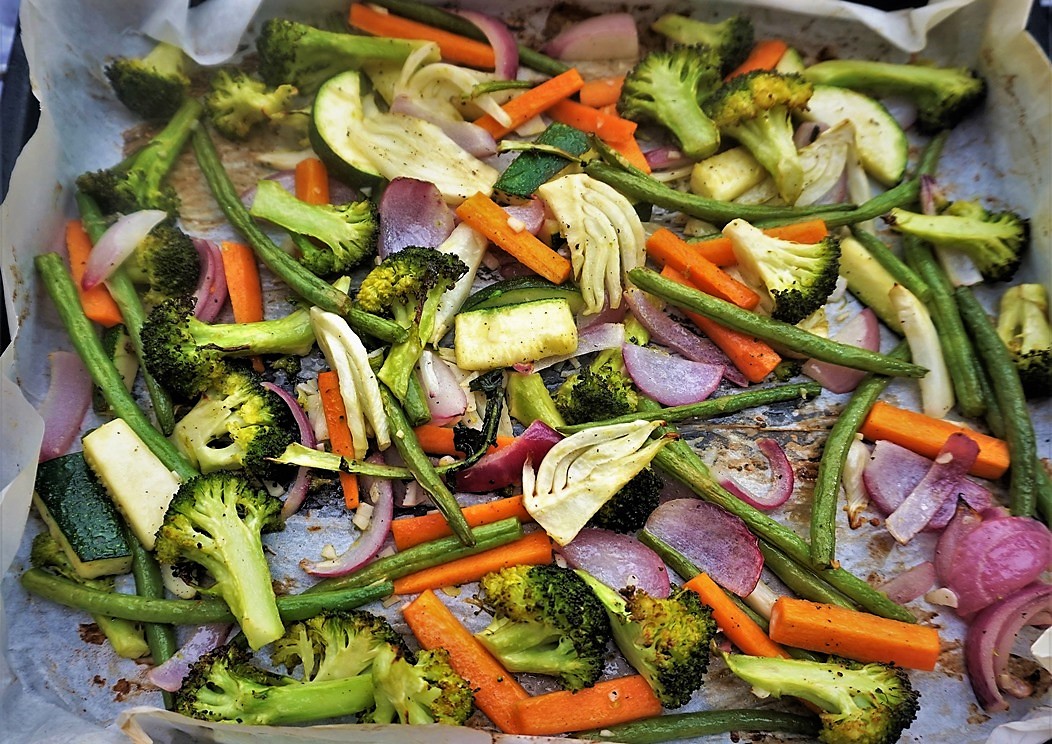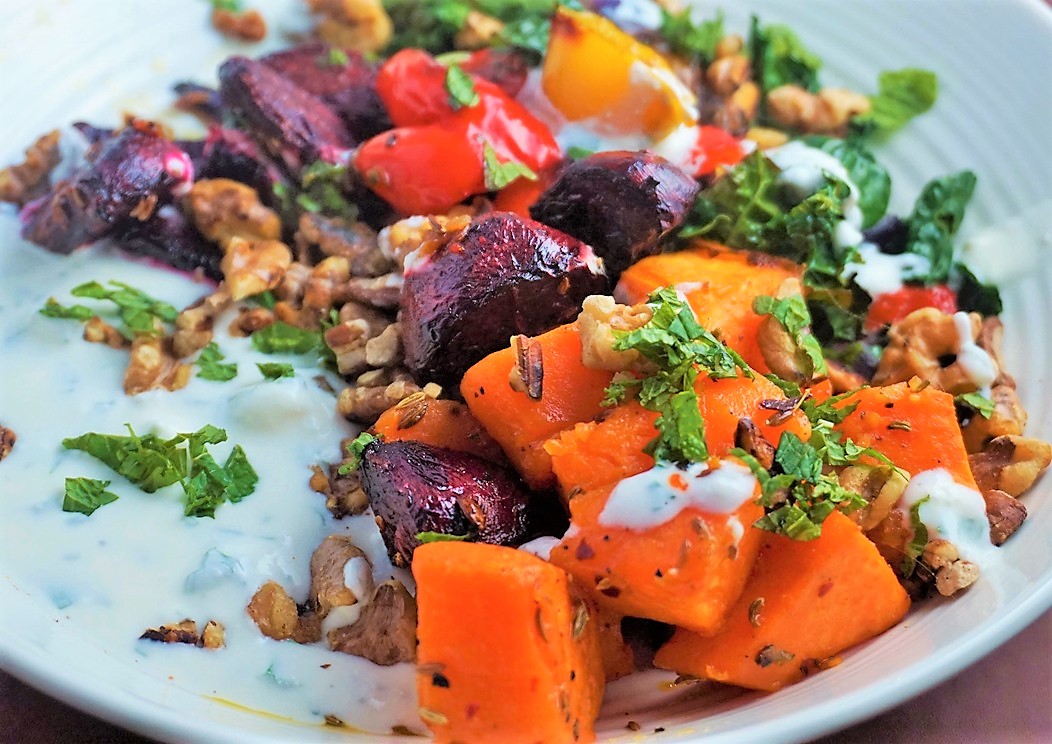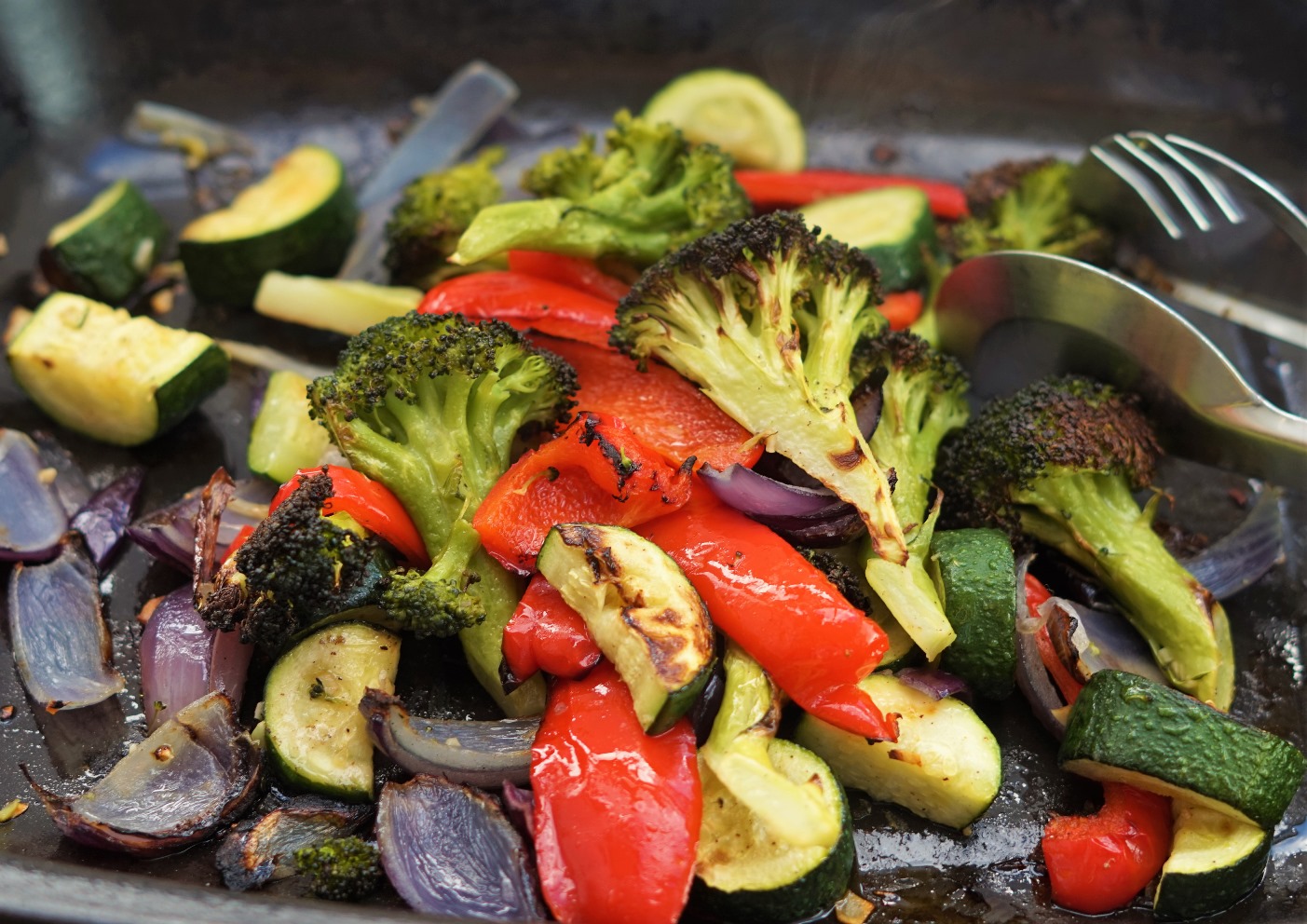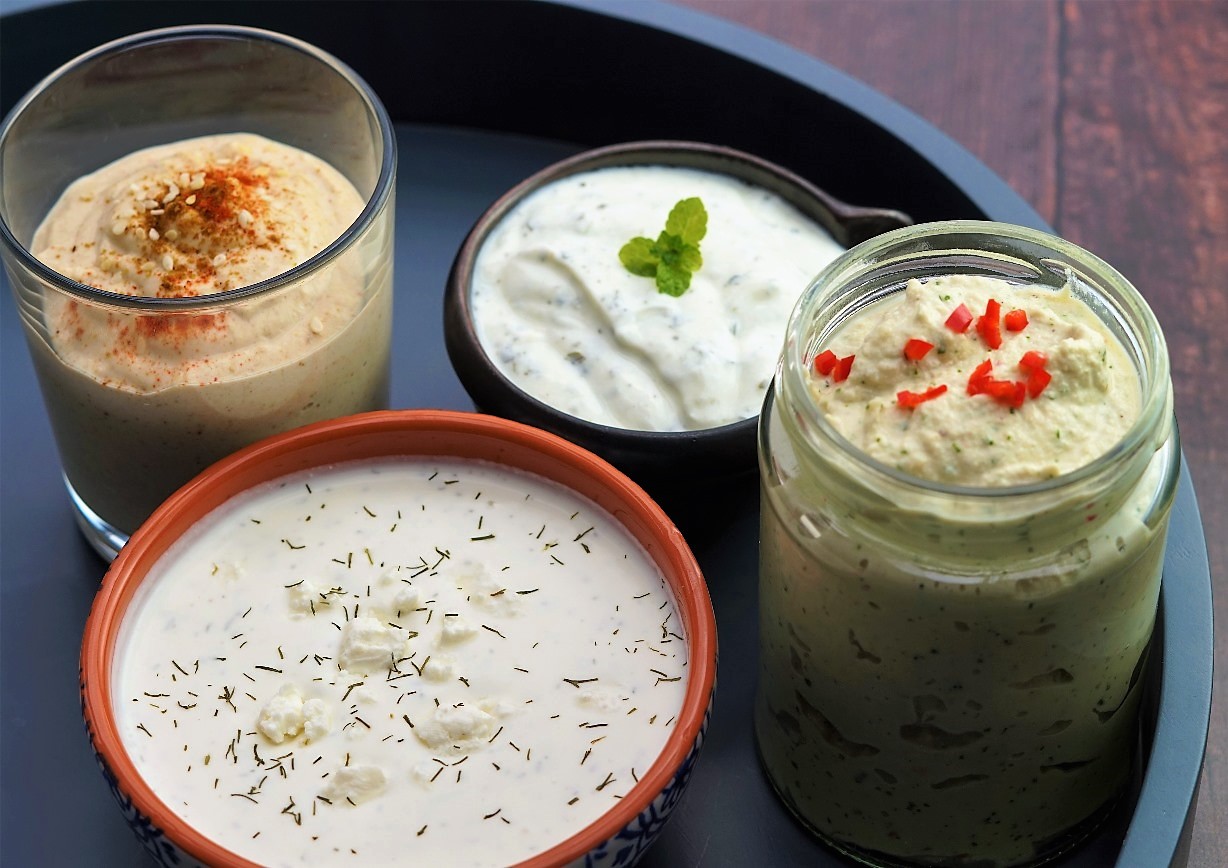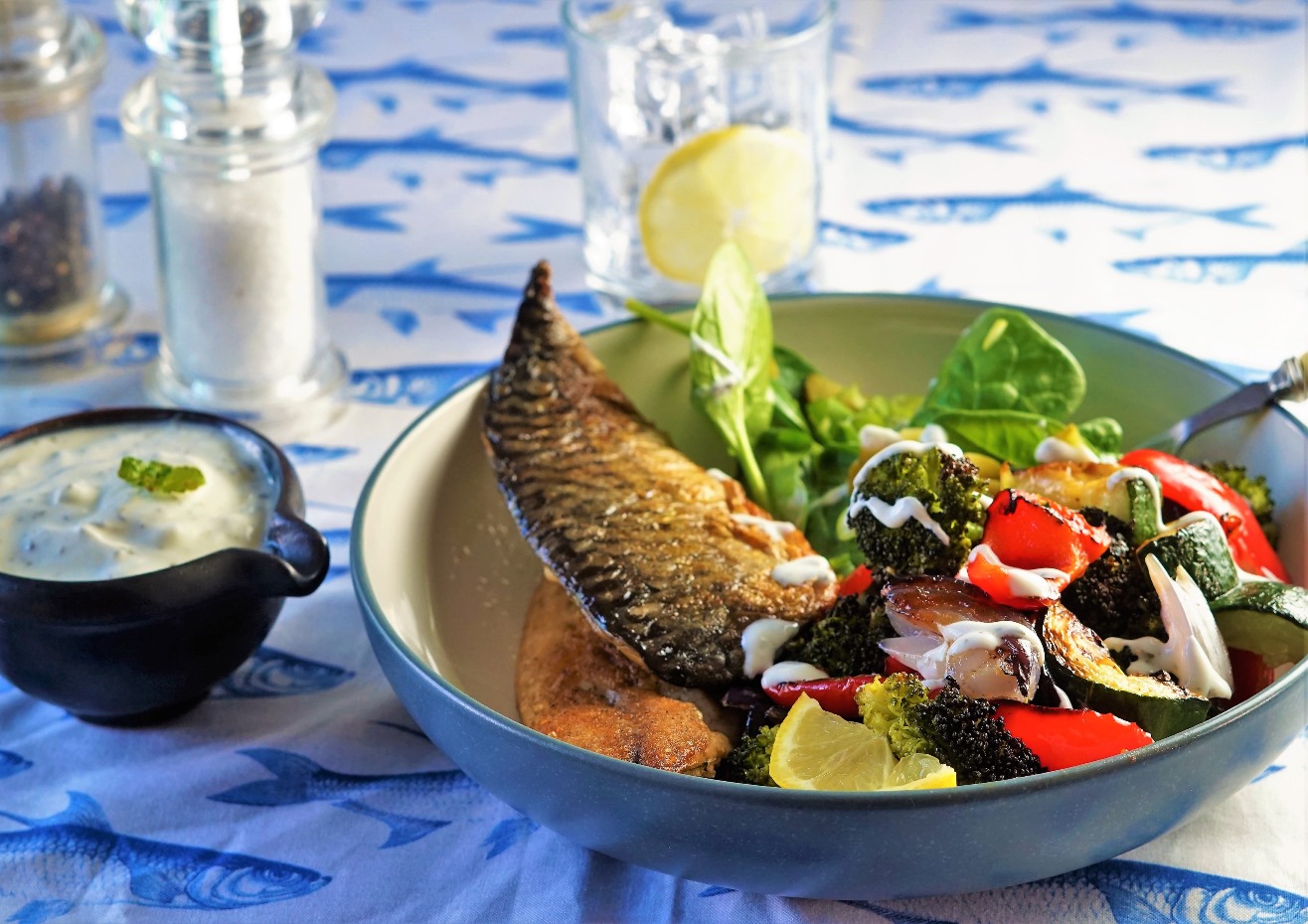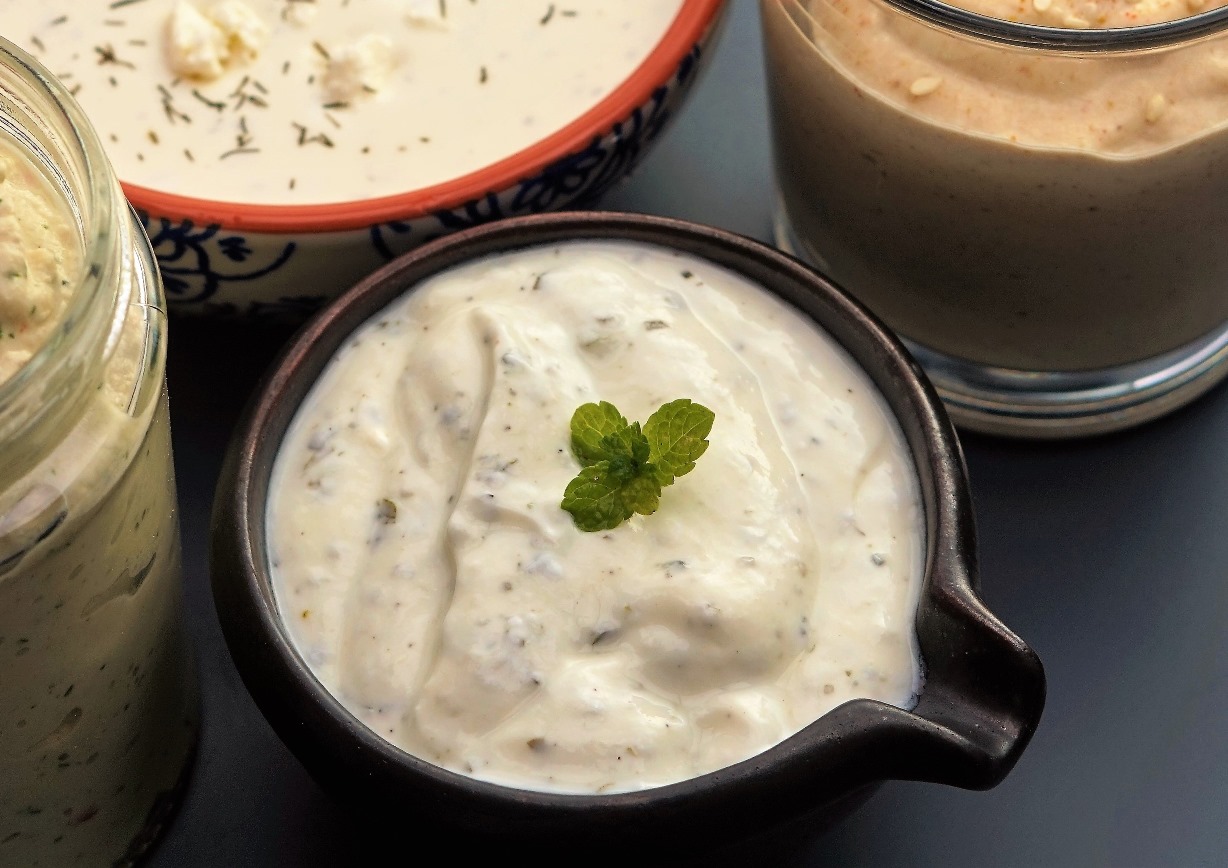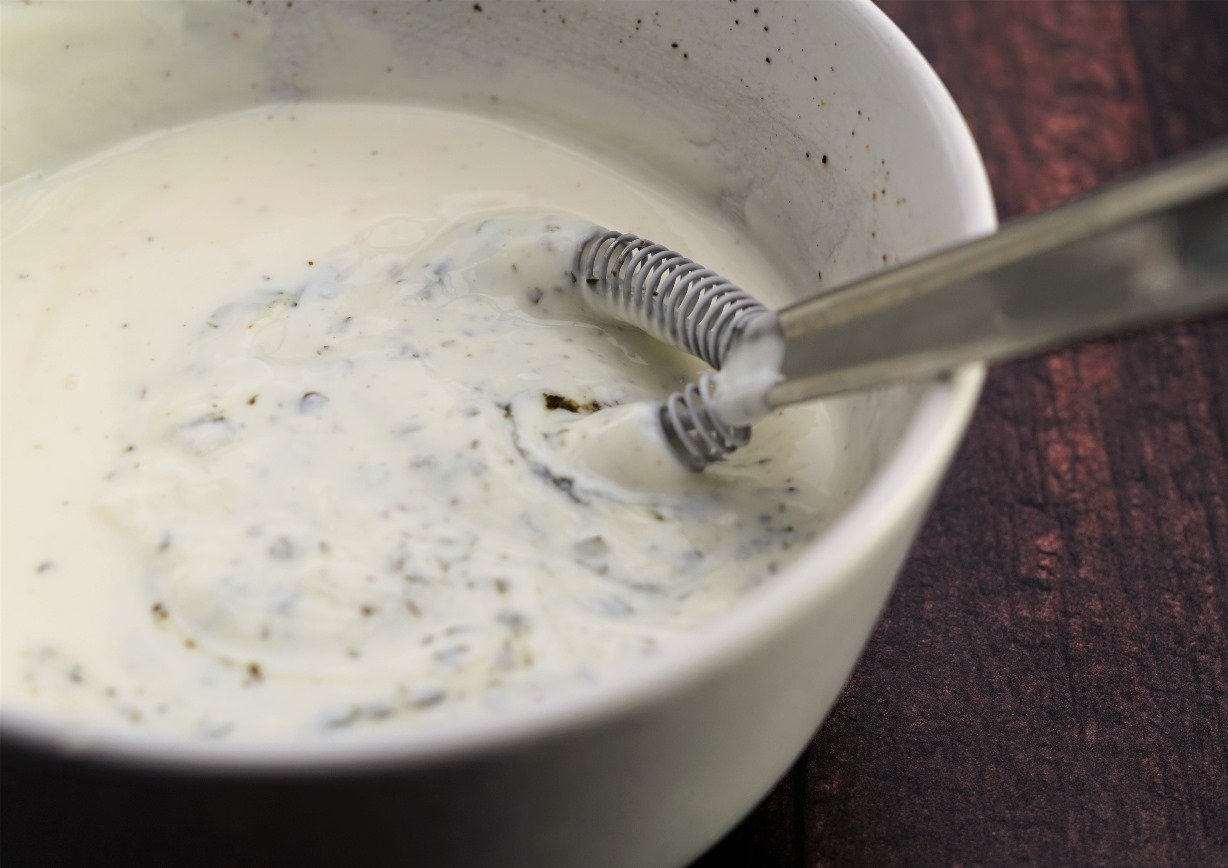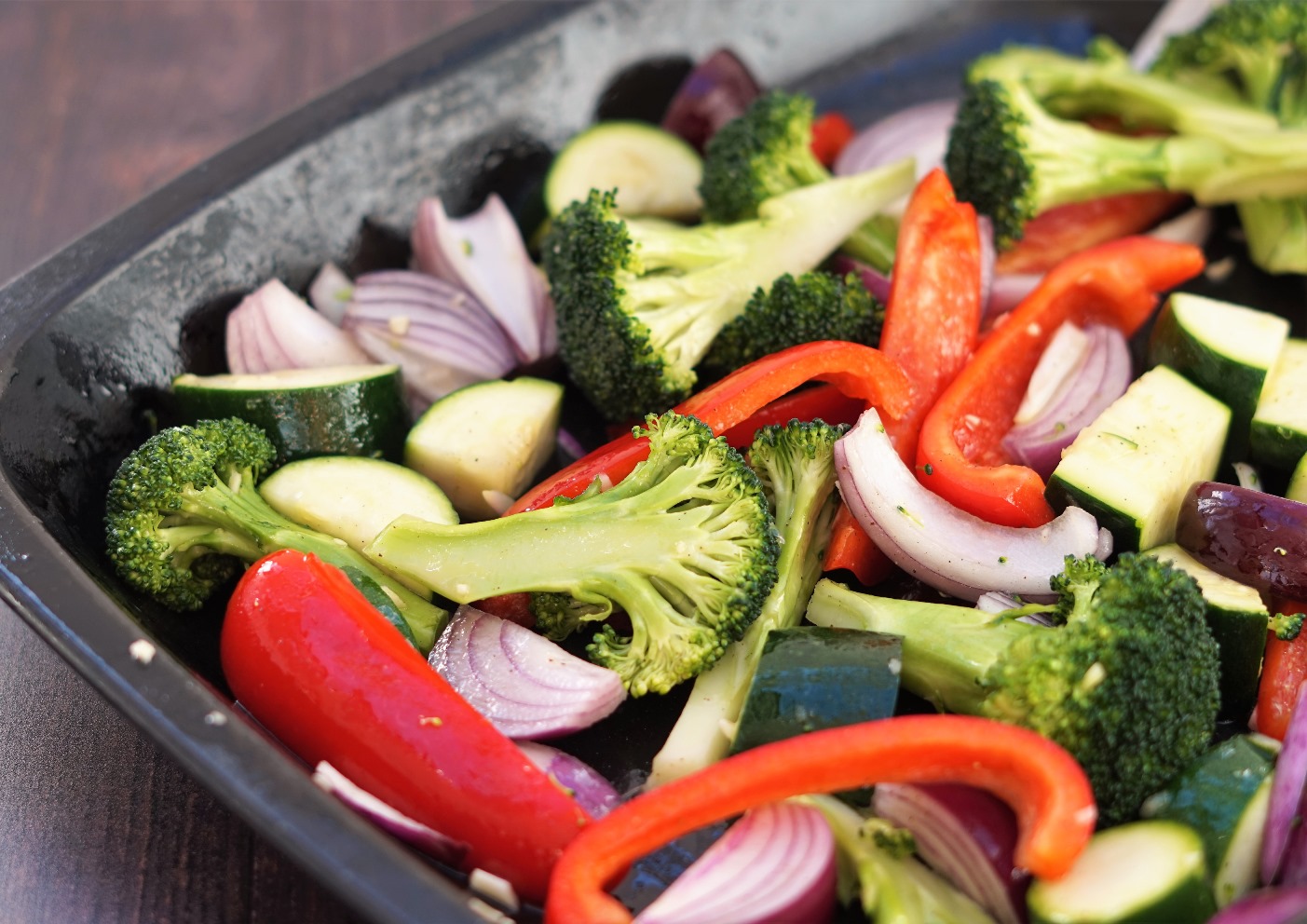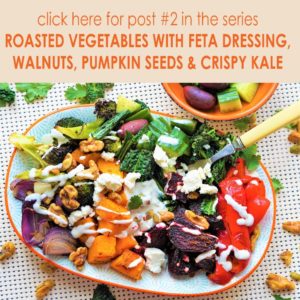Roasted vegetables with mix & match dressings
This post is the first in a series where I’ll show you how roasted vegetables, accompanied by a range of tasty mix and match dressings, are a great way to help you reach your recommended daily intake of fruit and vegetables. In this post I share a recipe for Roasted Vegetables with Yogurt, Lemon & Mint Dressing served with Pan-Fried Mackerel Fillets.
Despite all the publicity and public exhortations to do the right thing, it seems that most people in Britain are still struggling to eat the recommended minimum of five portions of fruit and vegetables per day.
A 2017 study by Diabetes UK found that two thirds of adults ate three or less portions on an average day. That’s perhaps not surprising as three-quarters of those surveyed said they were confused about what constitutes a portion and almost a tenth felt that vegetables took too long to prepare.
Do you want to get more vegetables in your diet?
If you’re one of the 58% of people who say they want to eat more vegetables but aren’t sure how to do it, then I’m going to show you in this post (and in linked posts over the coming months) a quick, tasty and easy way to increase your intake of veg: simple, fast roasting that brings out all their flavour and which I’ll match with some tasty dressings and a range of proteins.
I’m going to concentrate on vegetables as I think they’re the most nutritionally valuable, whereas many fruits are quite high in sugar. Also, I think people tend to find it easier to incorporate two portions of fruit in their daily diet – for example a banana at breakfast and an apple with lunch or as a snack – as they need no preparation.
Of course you can include fruit and vegetables in juices and smoothies, but no matter how many glasses of these you drink in one day, they’ll still only count as one portion. That’s because it’s thought that the bulk provided by eating lots of whole fruits and vegetables has beneficial effects on the bowel, and you won’t get those benefits from drinking juices and smoothies. However, there’s also the view that juicing and liquidizing fruit and vegetables makes some of the nutrients more available to us so, on balance, I think it’s probably not a bad idea to include a fresh juice or smoothie once a day. But try to favour vegetables and go easy on high-sugar fruits as, for example, a glass of orange juice could contain almost four teaspoons of sugar.
What exactly is a portion?
Firstly, you need to know that a portion of vegetables or fruit is approximately 80 grams. I’ve weighed the vegetables for the recipes in this series in order to demonstrate just how many portions you can tick off in one meal, but with experience you don’t need to do that. Here’s a few examples to give you an idea of what one portion looks like:
- Broccoli or cauliflower: 8 florets
- Celery: 1 stick
- Cucumber: 5 cm
- Onion: 1 medium
- Pepper: ½ medium
- Tomatoes: 7 cherry or 1 medium
- Whole fruits such as apple, banana, orange, peach, pear: 1 medium
- Vegetables prior to cooking such as sliced carrots, shredded cabbage, peas: 3 tablespoons
For more examples of what a portion looks like, the NHS has a useful list which you can view or download here
An important point to note, potato-loving people of Britain, is that regular, white potatoes do NOT count as a vegetable portion. This is because they’re mainly carbohydrates and most of us are already getting enough (and many of us, way more than enough) of those. You can include sweet potatoes but, as they’re quite high in sugar, you might want to just have them only occasionally if you already have a lot of sugar in your diet.
If you currently eat five portions of fruit and veg every day: well done! But be aware that the recommendation of five is the MINIMUM amount of fruit and veg considered necessary for good health, so maybe you could still benefit from increasing your intake. There’s also an argument that five was selected as a goal because, with so many people in the UK eating next to no fruit and vegetables, to set the bar as high as it possibly should be (some say anything between 7 and 11 portions a day is preferable) would be a dispiritingly impossible goal from the current, pretty abysmal, average intake.
What’s Britain’s problem with vegetables?
I think the main reason we have so much trouble in Britain eating our vegetables is that we see them as an ‘add-on’ or optional extra to the protein and carbohydrates that make up the bulk of our meals.
That’s possibly true even for vegetarians or vegans as there’s so much ultra-processed junk and synthetic ‘meat’ being promoted these days that, even among those groups, natural foods like vegetables are getting pushed aside. If you think that sounds far-fetched, take a look at the fake meat ‘Impossible Burger’ that’s supposedly going to revolutionize the way we eat and which is made largely of water and textured wheat protein. When I was vegetarian then vegan, many years ago, I wouldn’t have dreamt of eating such a thing and made burgers, patties and the like from vegetables and pulses.
Although I’m now a committed omnivore, I still find that making vegetables the centre of a large proportion of my main meals makes it so much easier to consume healthy levels of vegetables.
Increasing your vegetable intake will necessarily be more expensive if you just add them to your existing diet. However, if you can cut down some of the carbohydrates (and protein if you eat a lot of it), you may find the cost difference not so great. But I don’t say that lightly as I know there is a great deal of food poverty in Britain today and simply making food swaps is not an option for millions of people, particularly as the food that’s worst for our health is often the cheapest.
The pattern of main meals in an average week at our house looks like this:
Monday: fish
Tuesday & Wednesday: vegetarian or vegan
Thursday: chicken
Friday: fish or red meat
Saturday & Sunday: one day will almost always be red meat, the other day could be red meat, chicken, fish, vegetarian or vegan.
We also limit our carbohydrate intake Monday to Thursdays, usually having no bread, pasta, rice, potatoes or similar with our main meals.
Quick-roasted vegetables: the secret to increasing your veggie portions
While in the summer I’m happy to knock up a big salad of raw vegetables to sit alongside a piece of fish, chicken, quiche, falafel or similar, I find that through large parts of the year I really want some warming food as the basis of my main meal.
I’ve always regarded plain boiled vegetables as pretty boring (with the exception of seasonal treats like British asparagus, green beans, runner beans and corn on the cob) and that’s why I find quick-roasted vegetables a great alternative. For the last year or two we’ve eaten roast vegetables, accompanied by protein such as fish, chicken, cheese, nuts or pulses, probably three or four times a week. For added flavour and nutrition, I also add a dressing of some kind.
For example, below is a bowl of spiced and roasted sweet potato, beetroot, red onions, peppers and kale with a feta and yogurt sauce and some walnuts. In this case, the feta cheese acted as both protein (along with the nuts) as well as a dressing. Besides being a very satisfying dinner, it contained FOUR portions of vegetables so, assuming you’ve had at least one piece of fruit during the day then you’ll have hit your minimum requirement for fruit and vegetables rather easily.
Emphasis on quick roasted
What you mustn’t think is that because we’re roasting, a lot of time is involved. Yes, peeling and chopping vegetables does take a bit of time but not a great deal. To keep as much nutrition in the vegetables as possible, I cook them at a pretty high heat – you want them to get a bit charred around the edges but still have some bite and texture. With the exception of hard vegetables like raw beetroot, most veg will roast in 10-12 minutes at 220C/425F/Gas 7.
While you can add the vegetables at different times depending on how long they need to cook, I prefer not to faff about and just cut them in appropriate sizes so I can throw them all in at once (again, with the exception of very hard veg which I cook in a separate dish). For example, carrots are much harder than peppers, so I cut them into thinner batons and the peppers into thicker ones, and they end up needing the same approximate cooking time.
Roast vegetables make excellent leftovers too when added to sandwiches, soups, pasta, salads etc., so it might be worth making a larger batch to increase the vegetable content of other meals too. Personally, I wouldn’t freeze leftover roasted vegetables as I find they lose too much of their texture and flavour.
Mixing & Matching
Over several posts, I'[m going to show you different meals based on roasted vegetables, each having a different dressing or sauce and accompanied by a different protein. At the end of the series you’ll see that the sauces can be mixed and matched with the different proteins and no doubt you’ll have your own favourite combinations of vegetables to serve them with.
Each week, try to include as wide a range of vegetables as you can, with lots of different colours – not only for visual interest but because the colour of vegetables is determined by natural compounds (phytochemicals) that are linked to a range of health benefits. Click here to read more about the benefits of eating differently coloured foods.
Roasted Vegetables with Yogurt, Lemon & Mint Dressing & Pan-fried Mackerel
While all the meals featured in this series will be simple, this first one is probably the simplest of all.
Vegetables are seasoned with salt and pepper, a little finely chopped garlic and drizzled with olive oil. They’ll take around 12 minutes to roast, during which time you fry a couple of mackerel fillets per person.
Because it’s so quick, I always make the dressing first – but that takes next to no time too. Simply whisk together full fat, natural yogurt with the juice of half a lemon, some salt and pepper and mint. When fresh mint is out of season and there’s none in my garden, I use jarred mint – try to find one that’s just labelled mint or garden mint rather than mint sauce, as the former should have a higher proportion of the herb.
The vegetables I used here, for 2 people, were a large courgette, half a head of broccoli, 2 medium red onions, 1 large red pepper and 1 large clove of garlic. These weighed over 700 grams which represents more than 4 portions of vegetables per person.
With most meals – for nutrition, variety and texture – I like to include a raw element and for this dish I added a little spinach, chopped gherkin and spring onion. This also has the benefit of adding about another third to a half portion of veg too.
Do you struggle to eat the recommended minimum portions of fruit and vegetables? If not, what sort of meals do you cook that incorporate lots of veg?
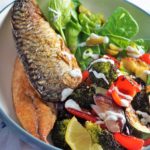
Roasted Vegetables with Yogurt, Lemon & Mint Dressing & Pan-Fried Mackerel
Ingredients
For the Yogurt, Lemon & Mint Dressing
- 200 g full fat yogurt
- 1/2 lemon, juice only
- 1-2 tbsp fresh mint, chopped OR 2 tsp jarred mint
- salt & black pepper to taste
For the roasted vegetables
- 1 large courgette (approx 225g) in large chunks or batons
- 1/2 head broccoli (appox 200g) separated into florets
- 2 medium red onion (approx 160g in total) quartered
- 1 large red pepper (approx 130g) cut into thick batons
- salt & black pepper to taste
- 1-2 cloves garlic finely chopped
- 2 tbsp olive oil
For the pan-fried mackerel
- 4 fillets mackerel
- salt & black pepper to taste
- 2 tsp olive oil
Instructions
-
Preheat oven to 220C/425F/Gas 7
For the Yogurt, Lemon & Mint Dressing
-
Put all the ingredients in a bowl and whisk to combine. Set aside until ready to serve.
For the roasted vegetables
-
Put the prepared vegetables in a large baking tray, season with salt and pepper and sprinkle over the chopped garlic. Drizzle with the olive oil and combine so that the vegetables are evenly coated in the seasonings and the oil.
-
Put the baking tray in the hot oven and roast the vegetables, stirring once or twice, until they have charred a little and are done to your liking (10-15 min).
For the pan-fried mackerel
-
Heat the olive oil in a non-stick frying pan to a moderate heat and season the mackerel fillets with a little salt and some black pepper.
-
Fry the mackerel fillets on both sides , Two at a time if necessary, until they are nicely browned, cooked all the way through and the skin side is crispy (5-6 min). Leave in a warm place while you cook the rest of the mackerel.
To serve
-
Divide the roasted vegetables and the mackerel fillets onto two plates. Drizzle some of the Yogurt, Lemon & Mint Dressing over the vegetables, serving the rest on the side.
-
If liked, serve with some raw spinach sprinkled with chopped gherkin and spring onion.

